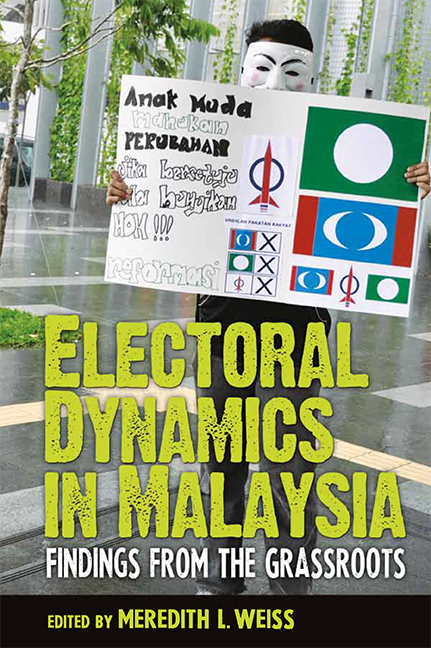Book contents
- Frontmatter
- Contents
- List of Tables
- Foreword
- Acknowledgements
- Glossary & Acronyms
- Chapter 1 Introduction: Patterns and Puzzles in Malaysian Electoral Dynamics
- Chapter 2 Arau, Perlis: The Irresistible Charm of Warlords, Women and Rewards?
- Chapter 3 Padang Serai, Kedah: Between the ‘Personal Touch’ and the Generous Hand
- Chapter 4 Kuala Nerus, Terengganu: New Malay Politics?
- Chapter 5 Balik Pulau, Penang: Home Run for the Home Boys
- Chapter 6 Lumut, Perak: Patronage, Clientelism and the Post-Coup Order
- Chapter 7 Kuantan, Pahang: Revealing the Ordinary
- Chapter 8 Pandan, Selangor: New Electoral Dynamics in Urban Malaysia
- Chapter 9 Kepong and Titiwangsa, Kuala Lumpur: Messages or Money?
- Chapter 10 Rembau, Negeri Sembilan: Personalities and Promises
- Chapter 11 Pulai, Johor: A Tale of Two Coalitions
- Chapter 12 Gelang Patah, Johor: Did Lim Kit Siang Truly Win His Last Gamble?
- Chapter 13 Kota Marudu and Keningau, Sabah: Personality, Patronage and Parochial Politics
- Chapter 14 Tuaran, Sabah: Party Loyalty and Rational Voting
- Chapter 15 Kota Kinabalu, Sabah: BN Loses Its ‘Fixed Deposit’
- Chapter 16 Beaufort, Sabah: Whither Lajim's Popularity?
- Chapter 17 Sibu and Lanang, Sarawak: Defeat of the Bosses
- Contributors
Chapter 6 - Lumut, Perak: Patronage, Clientelism and the Post-Coup Order
Published online by Cambridge University Press: 10 November 2017
- Frontmatter
- Contents
- List of Tables
- Foreword
- Acknowledgements
- Glossary & Acronyms
- Chapter 1 Introduction: Patterns and Puzzles in Malaysian Electoral Dynamics
- Chapter 2 Arau, Perlis: The Irresistible Charm of Warlords, Women and Rewards?
- Chapter 3 Padang Serai, Kedah: Between the ‘Personal Touch’ and the Generous Hand
- Chapter 4 Kuala Nerus, Terengganu: New Malay Politics?
- Chapter 5 Balik Pulau, Penang: Home Run for the Home Boys
- Chapter 6 Lumut, Perak: Patronage, Clientelism and the Post-Coup Order
- Chapter 7 Kuantan, Pahang: Revealing the Ordinary
- Chapter 8 Pandan, Selangor: New Electoral Dynamics in Urban Malaysia
- Chapter 9 Kepong and Titiwangsa, Kuala Lumpur: Messages or Money?
- Chapter 10 Rembau, Negeri Sembilan: Personalities and Promises
- Chapter 11 Pulai, Johor: A Tale of Two Coalitions
- Chapter 12 Gelang Patah, Johor: Did Lim Kit Siang Truly Win His Last Gamble?
- Chapter 13 Kota Marudu and Keningau, Sabah: Personality, Patronage and Parochial Politics
- Chapter 14 Tuaran, Sabah: Party Loyalty and Rational Voting
- Chapter 15 Kota Kinabalu, Sabah: BN Loses Its ‘Fixed Deposit’
- Chapter 16 Beaufort, Sabah: Whither Lajim's Popularity?
- Chapter 17 Sibu and Lanang, Sarawak: Defeat of the Bosses
- Contributors
Summary
Introduction
The semi-urban parliamentary constituency of Lumut comprises the Malay-majority state seats of Pangkor and Pasir Panjang as well as Chinesemajority Sitiawan. It is the site of electoral contests involving such major Perakian politicians as the state's United Malays National Organisation (UMNO) Chief Minister Zambry bin Abdul Kadir; Perak Democratic Action Party (DAP) chairman Ngeh Koo Ham; and Kong Cho Ha of the Malaysian Chinese Association (MCA), who served as Minister of Transport from 2010–13 and is the party's secretary-general. In addition, the outgoing state assemblyman for Pasir Panjang is Mohammad Nizar Jamaluddin, from Parti Islam SeMalaysia (PAS), who served as the state's Chief Minister for several months in 2009 before Zambry replaced him in what is commonly referred to as the ‘Perak coup’.
This coastal district's economic activities include tourism, fishing and agriculture. Levels of urbanisation and wealth are spread unevenly across subdistricts and ethnic groups. In addition, Lumut is home to a large naval base that hosts over 6,000 Royal Malaysian Navy personnel. More controversially, Brazilian mining giant Vale International SA's recent hefty investment in a jetty at Lumut Port has generated some backlash over the jetty's potentially harmful effects on the fisheries sector and on the environment.
The campaign in Lumut illustrates the nexus between the Barisan Nasional (BN) and government machinery, including the parallels between an election-triggered controversy over the naval base and the legal tussles following the 2009 Perak coup. Despite the BN's indisputable advantage, the campaign strategies of both coalitions converge insofar as they both fundamentally operate within and depend on a de facto legal framework that does not require the accountable use of state infrastructure and campaign funds. Still, the campaign in Lumut seemed to prompt a slight shift from ethnic-based to ‘economic’ mobilisation of votes.
Progress of the campaign
Campaign overview
Over the course of the campaign, the BN capitalised on state resources, expansive party machinery paid for by the central party organisation, a flood of mainstream advertisements and BR1M (Bantuan Rakyat 1Malaysia, 1Malaysia People's Aid) cash handouts to mobilise votes.
- Type
- Chapter
- Information
- Electoral Dynamics in MalaysiaFindings from the Grassroots, pp. 81 - 94Publisher: ISEAS–Yusof Ishak InstitutePrint publication year: 2013

